

Beyond the Chalkboard. Kitchen Science - Guest Post by Dr Jo Science Solutions. Christmas STEM - Santa STEM Challenges. Seven ways to improve science teaching, according to the EEF. The Education Endowment Foundation has published a new report on ‘improving secondary science’, which gives seven recommendations to try out in the classroom.
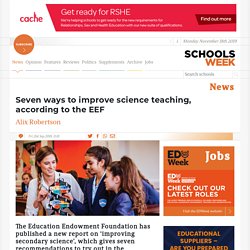
Science Magic - How to put a skewer through a balloon - Science Sparks. Embedding the Sustainable Development Goals (SDGs) in the curriculum - UK NAEE. This article by Joyce Hallam was published in NAEE’s most recent journal [Vol 120; Spring 2019] which has a focus on the sustainable development goals [SDGs].
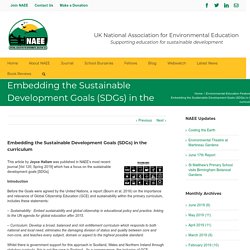
Introduction Before the Goals were agreed by the United Nations, a report (Bourn et al, 2016) on the importance and relevance of Global Citizenship Education (GCE) and sustainability within the primary curriculum, includes these statements: – Sustainability: Embed sustainability and global citizenship in educational policy and practice, linking to the UN agenda for global education after 2015. – Curriculum: Develop a broad, balanced and rich entitlement curriculum which responds to both national and local need, eliminates the damaging division of status and quality between core and non-core, and teaches every subject, domain or aspect to the highest possible standard.
BYOP - bring your own plant. Learnometer.net | heppell.net Higher than normal CO2 levels will directly impact badly on human cognition.
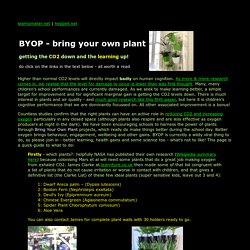
As more & more research comes in, we realise that the level for damage to occur is lower than was first thought. Many, many children's school performances are currently damaged. BYOP - bring your own plant. Wild Science - Benefits of Animal Experiences. Writing in Science: Guest post by Hochman and Wexler. School Garden Grants. When do practicals work well in science? Do pupils learn more science when they’re taught in classrooms – with the teacher explaining concepts – or in labs, through pupil experimentation?
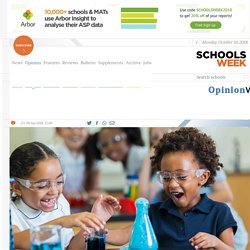
Phil Naylor takes a look at what the research says, and shares some tips for effective science teaching “Are we doing a practical, sir?” Screams the excited year 9 down the corridor, as they realise that we’ve had a room change. “Love practicals, sir!” While this is a familiar scenario for many science teachers, there is a running debate in the profession as to the value of practical work. With the advent of modular exams and Building Schools for the Future, we saw a reduction in the number of labs, and science lessons taught in classrooms are on the increase. Forest School for Trads – Solomon Kingsnorth. I’ve learned a lot from traditionalist teachers: the effectiveness of direct instruction, the relevance of cognitive science and the importance of knowledge.

These are the mainstays of my teaching practice, and I’ve always liked one of the more common traditionalist refrains — that we should focus on teaching the ‘best that has been thought and said’ (as problematic as such a thought may be). However, there is something missing in almost all of the traditionalist discourse, and that is…nature. Or more specifically, the importance of children spending time in and learning about nature. Before writing this blog, I began a foray into the research around the benefits of nature: restoring cognitive function, reducing blood pressure, increasing self-control etc. Then I stopped. Month by month guide to an edible school garden- autumn term. VegPlanner. Vegetable crop planner. Sowing and growing vegetables It is useful to know how long different vegetable seeds take to germinate, to avoid unnecessary worry that seeds are not going to grow and to realise that you just have to be patient.
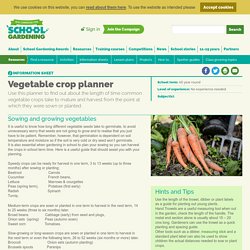
Remember, however, that germination is dependent on soil temperature and moisture so if the soil is very cold or dry seed won’t germinate. It is also essential when gardening in school to plan your sowing so you can harvest the crops in school term time. Here is a useful guide that should assist you with your planning. Speedy crops can be ready for harvest in one term, 3 to 13 weeks (up to three months) after sowing or planting; Beetroot Carrots Cucumber French beans, Lettuce Marrows & courgettes Peas (spring term), Potatoes (first early) Radish Spinach Turnip.
Medium-term crops are sown or planted in one term to harvest in the next term, 14 to 25 weeks (three to six months) later. Planning the spacing for your vegetables Crop spacing in traditional open allotment style growing. Playing Field Plants Project Guide - FSC. Primary-guide-sample. Dramatic Science. Overview of TAPS Focused Assessment plans.
Assessment (TAPS) - Curriculum Materials. Downloads require pop ups to be enabled for your browser.
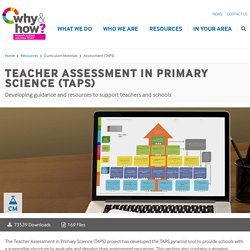
If you are using a firewall, please ensure your settings permit this when using this site. Focused Assessment The TAPS focused assessment approach embeds assessment within classroom primary science activities. There are two kinds of resource in this database. There are plans that have a particular focus on the assessment of working scientifically, such as close observation within a topic context. The elements of working scientifically were chosen according to the natural emphasis of the topic and activity. Why use focused assessment? A focused assessment increases the validity of teacher judgments. Taking one focus at a time means that assessing science, including practical work, becomes more manageable with a whole class. They have been developed and trialled by schools so teachers can feel secure that their judgements are consistent with those of other teachers. Taps pyramid final. Primary science tests show results decline.